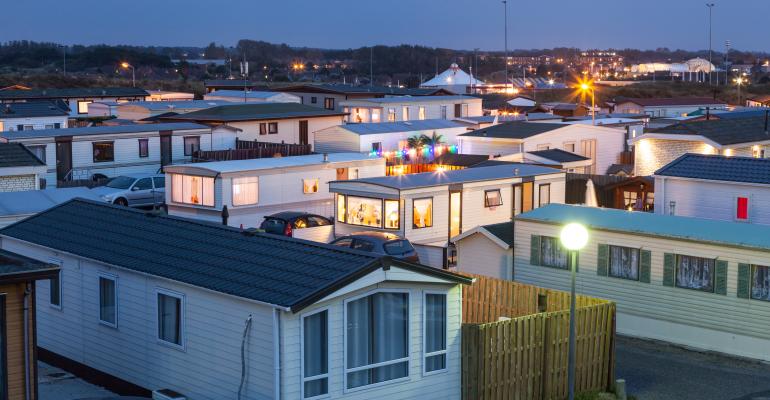Industry experts see plenty of room for growth in the manufactured home communities sector, particularly among the smaller properties.
Often referred to as mobile homes or trailers, manufactured home communities are, in fact, a specific type of factory-built housing, constructed in accordance with the U.S. Department of Housing and Urban Development’s (HUD’s) Manufactured Home Construction and Safety Standards Code. They should be distinguished from RVs, trailers and park-model homes.
Manufactured homes are an important source of affordable housing, particularly for rural and low-income residents, according to experts.
Within the last few years, some of the world’s largest private equity firms, and institutional investors, with more than $1.77 trillion in assets, have made investments in manufactured home communities across the U.S., according to a report by the Private Equity Stakeholder Project, MHAction and Americans for Financial Reform Education Fund.
There are some estimated 50,000 land lease communities of all sizes in the United States. Of these communities, a majority are properties comprised of 100 or fewer rental home sites, and a minority are properties with 100 or more rental home sites. The larger properties, consisting of 100 or more sites, are already widely owned by the 500 known major players.
For example, in mid-2018, the Blackstone Group bought a portfolio of manufactured home communities from Tricon Capital Group. Tricon reported that month the sale of 14 manufactured housing communities for an estimated $172 million.
In 2017, private equity firm Apollo Group management bought Inspire Communities, a manufactured home community operator with 13,000 home sites.
In 2016, the sovereign wealth fund for the Government of Singapore (GIC) and the Pennsylvania Public School Employees Retirement System bought a majority stake in Yes! Communities, one of the largest owners of manufactured home communities in the United States. Yes! Communities has since grown to 54,000 home sites by buying up additional manufactured home communities, according to a May 2018 company press release.
But as major real estate players target large manufactured home communities, other investors see opportunity for acquisition and growth among the smaller “mom & pop” properties.
“Actually, it’s a pretty active market; you just don’t hear about it,” says industry consultant George Allen, a manufactured housing manager and emeritus member of the Manufactured Housing Institute. “Not something of interest to big guys, but certainly good for a nice passive or active investment.”
Manufactured home communities are attractive investments for REITs, large private equity players and other investors due to their low annual turnover rates and low operating expense ratios. There is also a limited to almost no new supply of mobile home communities coming on-line; therefore, owners are relatively unchallenged by competition from newer properties.
“That’s what we’re doing. We’ll buy, the smallest I’ve done is 50 units, and we’ll buy that, and that’s okay,” says Hansel Rodriguez, principal at COARE Communities, a real estate company. “But what we’ll try to do is can we buy three 50-unit communities, because now it’s a portfolio.”
Operating multiple smaller mobile home communities in an area is advantageous because of economies of scale. This differs from operating apartment communities, as more apartments under ownership translates to higher operating expenses. For mobile home communities, the expenses remain relatively unchanged no matter the size of the community, as tenants are all required to take care of their homes inside and out.
“The larger a mobile home park is, frankly, the easier it is to manage. Just the opposite for apartment communities,” says Allen. “The point of the matter is a 200-site mobile home park is more than double the value than a 100-site mobile home park because of the way those numbers work.”
According to Allen, the highest return on a property he purchased was 60 percent. Rodriguez says the internal rate of return (IRR) on these investments can range from 15 to 20 percent. John Pawlowski, senior analyst at Green Street Advisors, pegs the internal rate of return on manufactured housing communities at an average of around seven percent.
“It’s extremely positive, it’s a sector we love versus basically any sector we cover,” says Pawlowski. “Green Street has loved this business for 30 years and continues to believe it’s cheap and underpriced in the stock market, in the public market and is a prime real estate vehicle as well.”





